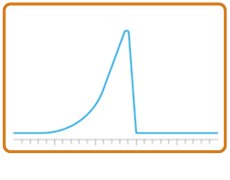Fronting Peaks
GC Troubleshooting Course
8 - Fronting Peaks
9 - Poor Peak Resolution
10 - Split Peaks
11 - Response Variability
12 - Retention Time Variability
13 - Course Summary & Test
Fronting Peaks

Fronting (or leading) peaks occur when the front of a peak shows a gradual increase, followed by a sharp decrease — the reverse of tailing. Though less common than tailing, fronting is a clear sign of a system imbalance and can affect quantitation accuracy.
What Does It Look Like?
A fronting peak appears skewed to the left (gradual rise, sharp fall), may be mistaken for a co-elution or early eluting compound.
Primary Causes & Fixes:
1. Column Overload
Cause: Too much analyte is injected, saturating the stationary phase. This prevents proper interaction and separation, causing front-loaded elution.
Symptoms:
- Affects large peaks in particular.
- More noticeable when peak heights are significantly above expected levels.
Fixes:
- Dilute the sample before injection.
- Increase the split ratio to send less sample onto the column.
- Use a column with a wider inner diameter (e.g., 0.32 mm instead of 0.25 mm) or a thicker film to increase phase capacity.
Reducing the load often restores normal peak shape immediately.
2. Incompatible Stationary Phase
Cause: Analyte-phase mismatch (e.g., non-polar compound on a highly polar column) reduces retention and distorts elution profile.
Symptoms:
- Only one or two individual peaks show fronting.
- Usually occurs during method development or when switching column chemistries.
Fixes:
- Select a stationary phase that matches analyte polarity.
- Check application notes, technical bulletins, or published methods for guidance.
- For problematic polar interactions consider alternative phases or derivatization of analytes.
Quick Peak Fronting Troubleshooting Guide
| Cause | Indication | Solution |
|---|---|---|
| Column overload | Multiple large peaks fronting | Dilute sample, increase split ratio, change column |
| Phase incompatibility | One or two peaks affected | Select a more suitable stationary phase |
Best Practices:
- Use calibration standards to identify peak shape changes early.
- Don’t rely solely on integration — inspect chromatogram peak shapes regularly.
- Log method changes and instrument parameters to trace issues efficiently.


